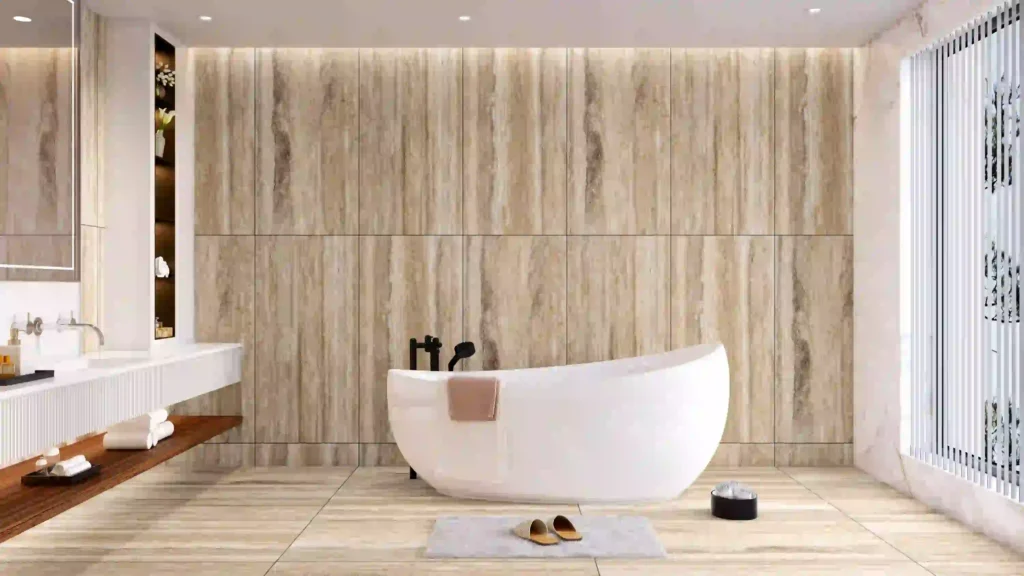Tree Tile is always trying, in order to solve environmental issues and promote sustainable practices in the building industry, eco-friendly materials are essential in the creation of tiles. Tiles are frequently used for walls, floors, and other surfaces, and the materials that go into making them can have a big impact on the environment. Here’s a thorough rundown of the environmentally friendly materials used in tile production
1. Recycled Materials
Glass: Recycled glass is a widely used environmentally beneficial material in the manufacture of tiles. It aids in the management of glass trash and lowers the need for fresh raw materials.
Ceramics: By utilizing recycled ceramics from post-consumer and post-industrial sources, the environmental impact of mining and processing raw materials can be minimized in the manufacturing of tiles.
2. Bamboo
Tree Tile have an idea of bamboo, which is a sustainable material that grows quickly and may be used to make tiles. Because of its quick growth, little environmental effect, and biodegradability, it is regarded as eco-friendly. Imagine floors that whisper of verdant forests, walls echoing with nature’s resilience. Bamboo tiles offer just that – a sustainable embrace for your space. This fast-growing wonder captures carbon, needs no pesticides, and biodegrades gracefully, leaving footprints only upon our hearts. Choose bamboo, and step into a sanctuary woven from nature’s whisper.
3. Cork
We know the bark of cork oak trees is used to make cork tiles. Since cork trees grow again after being harvested, it is a sustainable and renewable resource. Feel the soft tread of old oaks beneath your feet. Cork tiles are made from repurposed bark, and they provide warmth as you walk. Every harvest is a tender touch rather than a wound, and the trees are renewed annually. Breathe easily, for your sanctuary beats to the rhythm of nature, a timeless tapestry woven from the soft abundance of the soil.
4. Porcelain Tiles
We have durability of premium porcelain tiles are well-known. By reducing the need for replacements, using durable materials helps to reduce waste and resource usage. Steps resound on eternal porcelain, and time seems to fade away. Expertly crafted to endure a lifetime, these tiles gracefully withstand damage and deterioration. There’s less replacement and waste, and every step has a hint of accountability. Invest in the whisper of eternity and allow your environment to become a work of timeless beauty.
5. Recycled Metal
Metallic tiles glimmer where waste dances with renewal. It embraced salvaged steel and aluminium create a new life beneath the surface. Every tile is an example of ingenuity, a silent reminder of energy conservation and defied landfills. Select these gems, and let your room to reverberate with the beat of metamorphosis, where trash becomes treasure and wasted becomes brilliant.

6. Concrete with Fly Ash
In concrete tiles, fly ash, a by-product of burning coal, can partially replace cement. By doing this, the carbon footprint connected with the conventional cement production process is decreased in addition to making use of industrial waste. Fly ash-infused concrete tiles are a subtle contrast to the industrial din. Once destined for landfills, this recycled dust now finds redemption as a partial cement alternative, its dark gray flecks etching a tale of resourcefulness in stone.
7. Low VOC (Volatile Organic Compounds) Glazes
Tree Tile have some conventional tile glazes release volatile organic compounds, which are dangerous substances. Glazes with low or no volatile organic compounds (VOCs) improve indoor air quality and lessen the environmental effect of tile production. These tiles whisper secrets of healthy air. Low-VOC glazes dance across their surfaces, a gentle promise of pure breath and eco-conscious design. Every step a whisper of responsibility, every space a haven of well-being.
8. Adhesives based on water
Conventional adhesives frequently have solvents in them that can release dangerous substances. The emission of volatile organic compounds is reduced by water-based adhesives, making them a more environmentally friendly option. Choose water-based adhesives, and let your space become a sanctuary not just for beauty, but for clean air and ecological responsibility. With every step, feel the echo of progress, the delicate hum of a world choosing health over harm. Let your tiles become a testament to the quiet resilience of nature, a whispered promise of a future where progress and harmony walk hand-in-hand.
9. Local and Sustainable Sourcing
We using & locally obtained products can help cut down on emissions caused by transportation. Prioritizing commodities from sources that are sustainably managed also guarantees ethical gathering methods. Selecting tiles that are sourced locally makes you a harmonious weaver. You bind communities together, sustaining means of subsistence and preserving the environment that sustains life. You turn into an advocate for moral behaviour, making sure that appropriate harvesting techniques preserve the abundance of nature for future generations.
10. Manufacturing that is Energy-Efficient
Tree tile can further lessen their operations’ environmental impact by implementing energy-efficient production techniques, such as the use of renewable energy sources. A waltz of vitality weaved by the music of nature. Sunbeams caress kilns, supplying whispers of renewal to their flaming embrace. Whispering through turbines, wind spins green power threads that drive creation’s dance. These tiles embody energy-efficient artistic craftsmanship, their beauty forged in a sustainable embrace. They are more than simply tiles.
11. Standards and Certifications
Seek out tiles that meet environmental standards and certifications, including LEED (Leadership in Energy and Environmental Design) or other local eco-labels. The products’ compliance with particular environmental standards is guaranteed by these certificates.
Conclusion
To summarize, reducing the environmental impact of construction operations requires the use of eco-friendly materials in tile manufacture. These materials support the larger objectives of sustainable and responsible building practices by reducing waste, conserving resources, and creating a healthier interior environment.
PGVT tiles are a popular choice for homeowners and designers alike, and Morbi is home to some of the finest PGVT tiles manufacturers in the industry. With their exquisite designs, durable construction, and easy maintenance, PGVT tiles from Morbi’s manufacturers are the perfect blend of style and functionality. Whether you’re renovating your home or designing a commercial space, Morbi’s PGVT tiles industry offers endless possibilities to create stunning interiors that stand the test of time.




